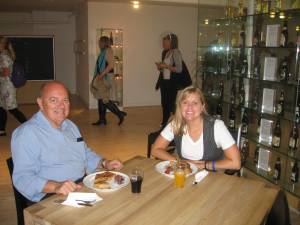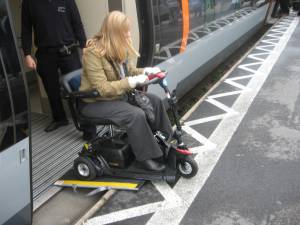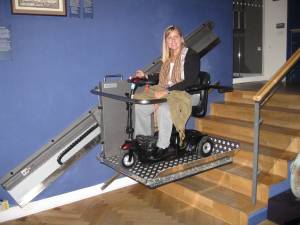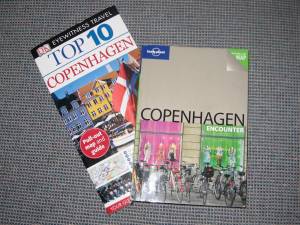
Dad and I enjoying lunch at the Carlsberg Brewery - we're not big beer drinkers, so we opted for free soda instead of beer at the end of the tour.
I’ve just returned from my annual father-daughter trip. This year we went to Copenhagen, Denmark. Each year instead of exchanging gifts and cards for birthdays and holidays, my father and I embark on a vacation together. Because of the difficulty I experienced with Pompe Disease, from the long diagnosis process, the pain and mobility issues, and putting together a treatment plan this was the first overseas trip I’ve been able to take since my condition really starting going downhill back in early 2009. I love to travel, and having that passion potentially sidelined by Pompe was not something I was happy about – so this trip meant a lot to me!
Since starting my treatment plan earlier this year, which includes Lumizyme infusions every other week, daily physical therapy, and a special diet I feel so much better than I did when 2010 began. With my new found strength (I still have a very long ways to go and still need a mobility scooter) we decided it was time to try an overseas trip. We chose Copenhagen for a couple of reasons. Neither one of us had ever been there (which is shocking because my father has been to almost 60 countries and I lived in Britain for over 2 years). Copenhagen claims to be “one of the most accessible European cities,” but there is only so much you can discover through the internet and we knew we could be taking a big chance traveling overseas which my mobility challenges. But, one of my new mottos is: I’ll never know what I CAN and can’t do unless I try. So we booked our trip, packed our bags and set out to discover Scandinavia.
Copenhagen is a picturesque city with an interesting history, filled with amazing sites, people, and delicious food. The people of Copenhagen couldn’t have been nicer and everyone seemed to go out of their way to offer to help. Locals stopped us on the streets to see if we needed directions, shop and restaurant staff members did everything they could to accommodate or try to accommodate me, and one patron in a coffee shop even asked if he could get my order for me when he noticed there were steps leading into the shop!
And as far as its claim to be accessible, I have to say for a European city that has streets and buildings that are older than America, Copenhagen is very accessible. There are of course places your wheels will not be able to take you, but like me – just focus on what you CAN DO! And in Copenhagen there is a lot you CAN DO if you have mobility issues.
Transportation

Me using the hand-placed ramp to exit the train. The regional trains and city buses are really your best bet for accessible tourist travel around Copenhagen.
The Metro, regional trains, and buses are all accessible. The s-train and the canal boats are not. The Metro however, does not really go to many tourist areas – it seems to be targeted more at getting the locals to and from work. In all honesty, you can get around the major sites of the city on foot (or on wheels) pretty easy as everything is fairly close together, and what is not can be easily reached by bus or regional train. The red Hop On Hop Off busses are also accessible and are a great way to see the city and get the lay of the land.
When boarding the trains, you need to get the attention of one of the staff members because they have to lay out a ramp by hand in order for wheelchairs to board. A good spot to wait is at the front of the train and as it approaches simply wave at the driver indicating you’d like to board and he/she will assist you.
Because Copenhagen is such an old city you will encounter a lot of cobble stone lined streets and sidewalks. This can be a little jarring for those of us traveling in wheelchairs – just take it slow. The city has made a real effort to make the sidewalks accessible as far as putting in “ramps” at crossings so curbs won’t be an obstacle. The ramps can be hard to spot as they blend in with the street – you sometimes have to be right on top of them before they become visible. I think I ran into all of two curbs that were a problem for my scooter. There was a lot of construction going on in the city so I think that partially contributed to my two little curb problems. But in both cases I was simply able to go around the intersection the “long way” to avoid those curbs.
Shopping and Dining
The shops and restaurants have varying accessibility. Some entrances allow you to just roll right in, others have steps which vary from one or two that are pretty manageable if you can walk a little, to huge stone stairs with no handrail. Many of the cafes offer sidewalk seating, and several have outdoor heaters which makes dinning outside very pleasant even in cooler weather.
If you come across a shop or restaurant that doesn’t look accessible – always ask about accessibility before moving on. We came across a few “hidden” entrances, from back doors to staff entrances – if the people of Copenhagen can find a way to get you inside, they will.
Museums and Galleries
 Like shops and restaurants, these are also hit and miss with their levels of accessibility. While most major museums boast they are accessible, there are limits to how accessible they can make a building built in the 1600’s. Again, ask first before deciding if you can or can’t enjoy one of these treasure troves. Some have installed stair lifts and/or ramps, others have yet to acquire the funding for this. Even the museums with limited accessibility are worth going and exploring the parts that are accessible.
Like shops and restaurants, these are also hit and miss with their levels of accessibility. While most major museums boast they are accessible, there are limits to how accessible they can make a building built in the 1600’s. Again, ask first before deciding if you can or can’t enjoy one of these treasure troves. Some have installed stair lifts and/or ramps, others have yet to acquire the funding for this. Even the museums with limited accessibility are worth going and exploring the parts that are accessible.
I’ll go into more detail about the specifics of my wonderful trip to Copenhagen and the levels of accessibility major sites offer disabled travelers in an upcoming post. I’ll even include how I was able to stick to my diet and exercise routine while traveling along with some other tips and tricks.

Both contain helpful information and pull-out maps, but to really get the most of your research you'll need both.
If you’re considering a trip to Copenhagen – do it! I recommend the books below for all travelers, but especially Copenhagen Encounter for disabled travelers as this book offers information on the accessibility of locations. The entries have a wheelchair symbol next to the locations which are considered accessible, but that doesn’t always mean they are completely accessible. Use it in combination with Top 10 Copenhagen as this book offers more details and lays out, as the title suggests, the best of the best.
Eyewitness Travel, Top 10 Copenhagen, by Antonia Cunningham